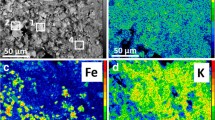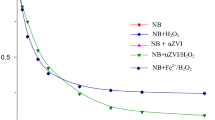Abstract
The present work compares the efficiency of homogenous Fenton and photo-Fenton processes in the presence of Fe(III)–EDDS complex under different experimental conditions. 4-tert-Butylphenol (4-t-BP), which is one of the endocrine disrupting chemicals, was used as a model pollutant to investigate the Fenton and photo-Fenton application. The efficiency of homogenous photo-Fenton process was significantly much higher than homogenous Fenton process, which is due to the rapid formation of Fe2+ under UV irradiation of the iron complex and the photochemical formation of HO• from the photolysis of the complex Fe(III)–EDDS. Through the degradation of 4-t-BP, the effect of Fe(III)–EDDS concentration, H2O2 concentration, pH, and oxygen was investigated in both processes. Such trend was also correlated with pH calculating the polychromatic Fe2+ quantum yield formation at pH 4.0, 6.0, and 8.6. The results showed that at high Fe(III)–EDDS and H2O2 concentrations, a negative effect was found. By the way, the Fenton process was found to be enhanced at basic pH. These results can be very useful for the use and optimization of such iron complex in water treatment process as function of different physico-chemical conditions.






Similar content being viewed by others
Explore related subjects
Discover the latest articles, news and stories from top researchers in related subjects.References
Barse AV, Chakrabarti T, Ghosh TK, Pal AK, Jadhao SB (2006) One-tenth dose of LC50 of 4-tert-butylphenol causes endocrine disruption and metabolic changes in Cyprinus carpio. Pestic Biochem Physiol 86:172–179
Bielski BHJ, Cabelli DE, Arudi RL, Ross AB (1985) Reactivity of HO2/O2 − radicals in aqueous solution. J Phys Chem Ref Data 14:1041–1100
Buxton GV, Greenstock CL, Helman WP, Ross AB (1988) Critical review of rate constants for reactions of hydrated electrons, hydrogen atoms and hydroxyl radicals (•OH/•O−) in aqueous solution. J Phys Chem Ref Data 17:513–886
Chen Y, Liu Z, Wang Z, Xue M, Zhu X, Tao T (2011) Photodegradation of propranolol by Fe(III)–citrate complexes: kinetics, mechanism and effect of environmental media. J Hazard Mater 194:202–208
ElShafei GMS, Yehia FZ, Dimitryb OIH, Badawib AM, Eshaq G (2010) Degradation of nitrobenzene at near neutral pH using Fe2+–glutamate complex as a homogeneous Fenton catalyst. Appl Catal, B 99:242–247
Fenton HJH (1894) Oxidation of tartaric acid in presence of iron. J Chem Soc, Trans 65:899–910
Furuichi T, Kannan K, Giesy JP, Masunaga S (2004) Contribution of known endocrine disrupting substances to the estrogenic activity in Tama River water samples from Japan using instrumental analysis and in vitro reporter gene assay. Water Res 38:4491–4501
Haavisto TE, Adamsson NA, Myllymaki SA, Toppari J, Paranko J (2003) Effects of 4-tert-octylphenol, 4-tert-butylphenol, and diethylstilbestrol on prenatal testosterone surge in the rat. Reprod Toxicol 17:593–605
Hermosilla D, Cortijo M, Huang CP (2009) Optimizing the treatment of landfill leachate by conventional Fenton and photo-Fenton processes. Sci Total Environ 407:3473–3481
Huang W, Brigante M, Wu F, Hanna K, Mailhot G (2012) Development of a new homogenous photo-Fenton process using Fe(III)–EDDS complexes. J Photochem Photobiol, A 239:17–23
Huang W, Brigante M, Wu F, Mousty C, Hanna K, Mailhot G (2013) Assessment of the Fe(III)–EDDS complex in Fenton-like processes: from the radical formation to the degradation of Bisphenol A. Environ Sci Technol 47:1952–1959
Inoue K, Yoshie Y, Kondo S, Yoshimura Y, Nakazawa H (2002) Determination of phenolic xenoestrogens in water by liquid chromatography with coulometric-array detection. J Chromatogr A 946:291–294
Jayson GG, Parsons BJ, Swallow AJ (1973) Oxidation of ferrous ions by perhydroxyl radicals. J Chem Soc, Faraday Trans 69:236–242
Kavitha V, Palanivelu K (2004) The role of ferrous ion in Fenton and photo-Fenton processes for the degradation of phenol. Chemosphere 55:1235–1243
Kok GL, Thompson K, Lazrus AL, McLaren SE (1986) Derivatization technique for the determination of peroxides in precipitation. Anal Chem 58:1192–1194
Kuo WG (1992) Decolorizing dye wastewater with Fenton’s reagent. Water Res 26:881–886
Lee C, Sedlak DL (2009) A novel homogeneous Fenton-like system with Fe(III)–phosphotungstate for oxidation of organic compounds at neutral pH values. J Mol Catal A: Chem 311:1–6
Li J, Mailhot G, Wu F, Deng N (2010) Photochemical efficiency of Fe(III)–EDDS complex: OH radical production and 17β-estradiol degradation. J Photochem Photobiol, A 212:1–7
Liu G, Zheng S, Xing X, Li Y, Yin D, Ding Y, Pang W (2010) Fe(III)–oxalate complexes mediated photolysis of aqueous alkylphenol ethoxylates under simulated sunlight conditions. Chemosphere 78:402–408
Mailhot G, Hykrdova L, Jirkovsky J, Lemr K, Grabner G, Bolte M (2004) Iron(III)-photoinduced degradation of 4-chloroaniline in aqueous solution. Appl Catal, B 50:25–35
Mestankova H, Mailhot G, Pilichowski J-F, Krysa J, Jirkovsky J, Bolte M (2004) Mineralisation of Monuron photoinduced by Fe(III) in aqueous solution. Chemosphere 57:1307–1315
Moody GJ (1963) The action of fenton’s reagent on carbohydrates. Tetrahedron 19:1705–1710
Myllymaki S, Haavisto T, Vainio M, Toppari J, Paranko J (2005) In vitro effects of diethylstilbestrol, genistein, 4-tert-butylphenol, and 4-tert-octylphenol on steroidogenic activity of isolated immature rat ovarian follicles. Toxicol Appl Pharmacol 204:69–80
Pignatello JJ, Oliveros E, MacKay A (2006) Advanced oxidation processes for organic contaminant destruction based on the fenton reaction and related chemistry. Crit Rev Env Sci Technol 36:1–84
Rothschild WG, Allen AO (1958) Studies in the radiolysis of ferrous sulfate solutions: III. Air-free solutions at higher pH. Radiat Res 8:101–110
Ruppert G, Bauer R, Heisler G (1993) The photo-Fenton reaction - an effective photochemical wastewater treatment process. J Photochem Photobiol, A 73:75–78
Rush JD, Bielski BHJ (1985) Pulse radiolytic studies of the reaction of perhydroxyl/superoxide O2 - with iron(II)/iron(III) ions. The reactivity of HO2/O2 - with ferric ions and its implication on the occurrence of the Haber-Weiss reaction. J Phys Chem 89:5062–5066
Subramanian B, Christou SY, Efstathiou AM, Namboodiri V, Dionysiou DD (2011) Regeneration of three-way automobile catalysts using biodegradable metal chelating agent-S, S-ethylenediamine disuccinic acid (S, S-EDDS). J Hazard Mater 186:999–1006
Torres RA, Pétrier C, Combet E, Moulet F, Pulgarin C (2006) Bisphenol A mineralization by integrated ultrasound-UV-iron (II) treatment. Environ Sci Technol 41:297–302
Uguz C, Togan I, Eroglu Y, Tabak I, Zengin M, Iscan M (2003) Alkylphenol concentrations in two rivers of Turkey. Environ Toxicol Pharmacol 14:87–88
Walling C, Goosen A (1973) Mechanism of the ferric ion catalyzed decomposition of hydrogen peroxide.Effect of organic substrates. J Am Chem Soc 95:2987–2991
Wu Y, Brigante M, Dong W, de Sainte-Claire P, Mailhot G (2014) Toward a better understanding of Fe(III)-EDDS photochemistry: theoretical stability calculation and experimental investigation of 4-tert-butylphenol degradation. J Phys Chem A 118:396–403
Yuan Z, VanBriesen JM (2006) The formation of intermediates in EDTA and NTA biodegradation. Environ Eng Sci 23:533–544
Zhang L, Zhu Z, Zhang R, Zheng C, Zhang H, Qiu Y, Zhao J (2008) Extraction of copper from sewage sludge using biodegradable chelant EDDS. J Environ Sci 20:970–974
Acknowledgments
The authors gratefully acknowledge financial support from China Scholarship Council for Dr. Yanlin Wu to study at the Blaise Pascal University in Clermont-Ferrand, France. This work was supported by the National Natural Science Foundation of China (NSFC 21077027), Shanghai Natural Science Fund (No. 12ZR1402000), Shanghai Tongji Gao Tingyao Environmental Science & Technology Development Foundation (STGEF), and the Graduate Innovative Fund of Fudan University (No. 13). This work was also supported by one project CMIRA founded by the Rhône-Alpes Région, the “Federation des Recherches en Environnement” through the CPER “Environnement” founded by the “Région Auvergne,” the French government and FEDER from the European community, and the CNRS program EC2CO.
Author information
Authors and Affiliations
Corresponding authors
Additional information
Responsible editor: Philippe Garrigues
Electronic supplementary material
Below is the link to the electronic supplementary material.
ESM 1
(DOC 242 kb)
Rights and permissions
About this article
Cite this article
Wu, Y., Passananti, M., Brigante, M. et al. Fe(III)–EDDS complex in Fenton and photo-Fenton processes: from the radical formation to the degradation of a target compound. Environ Sci Pollut Res 21, 12154–12162 (2014). https://doi.org/10.1007/s11356-014-2945-1
Received:
Accepted:
Published:
Issue Date:
DOI: https://doi.org/10.1007/s11356-014-2945-1




